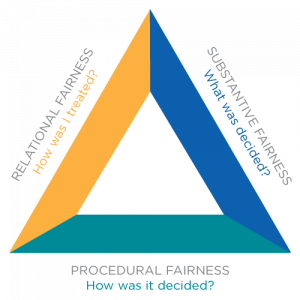Procedural Fairness
Procedural Fairness is about the process or steps that a body uses to come to a decision. It can sometimes be called Natural Justice. It asks the question: was the process fair?
Generally, a procedurally fair process needs:
- An impartial person (or persons) to make a decision
- Reasonable notice to the impacted person that a decision is going to be made
- Clear information about the criteria and process
- An opportunity for the person impacted to be heard and have their views considered
- Clear and meaningful reasons why a decision was made. Not just: “No, because I said so.”
- Information about how a decision can be reviewed or appealed
- A decision made within a reasonable amount of time
Examples:
A student is accused of misconduct under a policy that requires that the student is given an opportunity to respond. The person responsible for this, emails the student that they have been accused of misconduct and must meet with them within 48 hours or they will proceed without their input.
This person has acted in a procedurally unfair manner. 48 hours likely unreasonable given student’s workload, ability to access supports, and amount of stress an email like this can cause. There is little information provided about the process and the student has not been given details of the allegations, which does not allow them a reasonable opportunity to respond.
Instead, the person could have given the student:
-
- Comprehensive and specific details of the allegations including reference to the infringed policy section.
- A copy of or access to all evidence being used against them.
- Enough time to properly consider this information and seek support before being required to respond.
A student disagrees how a grade was determined. The student asks their instructor if the can talk about their grade, the instructor writes back: “All grades are final. Please refer to the course outline.”
This instructor has not provided a procedurally fair process. The student’s views have not been considered and the student is left with no path forward. The instructor has not given meaningful reasons behind their decision that respond to the student’s situation.
Instead, the instructor could have acted in a more procedurally fair manner by:
-
- Offering to hear the student’s situation over email or during office hours.
- Considering if the student’s circumstances warrant an exception to their policy or could qualify for an Academic Concession. Referring the student as appropriate.
- If the decision was still no, clearly communicating why and referring the student to the Review of Assigned Grade process or to the Chair of the Department for an appeal.
Tips for Decision Makers
- Many issues already have process outlined in a policy or procedure, especially if they are common or high-stakes situations. Even if a policy does not outline a step or there is no policy, it is still required to be procedurally fair.
- Consider that the potential impact and seriousness change how procedurally fair you must be. For lower-stakes decisions, an email or conversation may be appropriate. For higher-stakes decisions, all procedural fairness steps should be in place.
- When designing a process, consult the Ombudsperson. Consult with other department or units to see how they have designed processes. Consider looking outside UVic.
- When notifying students of academic integrity allegations consider using the Ombudsperson’s Template for an Academic Misconduct Notification Letter


